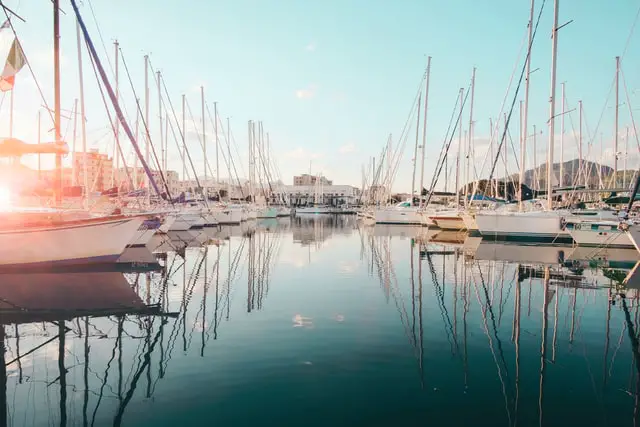Are marinas profitable? If you’re trying to find the answer to this question, you’ll soon realize that it is not an easy one to answer in the abstract.
This is because the profitability of a marina depends on many factors like its location, the type of harbor it is in, the kinds of boats that dock there, whether it is a commercial marina or a leisure marina, its fee structure, cost of utilities, etc.
In this article, we will deconstruct the various factors that influence the profitability of a marina and look at each in-depth.
So, if you are considering getting into the business of managing a marina or buying one, or simply launching a career in this field, you’ll know what factors you can (and cannot) control that affect your marina’s profitability.
Read on!
When Are Marinas Profitable? – Top Factors Affecting Profitability
The top factors that make one marina more profitable than another are:
- Location of the marina
- Type of harbor
- Commercial or Leisure
- Types of boats it attracts
- Fee structure
- Cost of utilities
- Amenities offered
- The Economy
1. Location of the Marina
The location of the marina is, perhaps, the most important factor affecting its profitability.
A marina situated in a prime spot will obviously be able to command higher rates and attract more clientele than one located in a remote area.
Further, a marina’s proximity to popular tourist destinations, shopping areas, and other attractions is also a key determinant of its success.
People are more likely to use a marina that is close to where they are already going to be spending their time.
2. The Type of Harbor
The type of harbor also plays an important role in the profitability of a marina.
For instance, a marina located in a harbor that is prone to bad weather conditions will have to invest more in maintenance and repairs, and also offer discounts and promotions to encourage customers to dock there.
On the other hand, a marina situated in a calm, easy-to-access harbor will have much lower operating costs and will be able to charge higher fees.
3. Commercial Marina or a Leisure Marina
Another factor that affects the profitability of a marina is whether it is a commercial marina or a leisure marina.
Commercial marinas are typically used by businesses and are able to charge higher fees. For instance, a marina could make a long-term contract with shipping companies which over the long run can be quite profitable.
Leisure marinas, on the other hand, are used primarily by individuals and families for recreation who are only willing to pay so much in docking fees.
While commercial marinas are generally more profitable than leisure marinas, they also require a higher level of investment.
4. Types of Boats Attracted
The kinds of boats that dock at a marina also have an impact on its profitability.
For example, a marina that caters to large yachts will be able to charge higher fees than one that only accepts small boats.
Similarly, a marina that is able to offer additional services like boat storage, repairs, and maintenance will also be more profitable than one that does not.
5. The Fee Structure
The fee structure of a marina also plays a role in its profitability.
A marina that charges hourly rates can be more profitable than one that charges monthly or annual rates. Of course, marinas with long-term contracts with boat owners tend to be more stable businesses than those that have a lot of churn, and rely on a large number of boats staying for short periods at a time.
However, it is important to note that the fee structure must be in line with the services offered and the location of the marina.
For instance, a marina located in a prime spot and offering high-end services can charge higher fees than one located in a remote area with fewer amenities.
6. The Cost of Utilities
The cost of utilities is also a factor that affects the profitability of a marina.
For example, a marina located in an area with high electricity rates will have higher operating costs than one located in an area with lower electricity rates.
Similarly, a marina situated in an area with high water rates will also have higher operating costs.
Usually, the cost of utilities will be reflected in a marina’s prices but when there are two marinas in the same vicinity, the one with lower costs will have a leg up over the one with higher costs.
7. Amenities Offered
Many boat owners will select a marina for its amenities and so these definitely impact a marina’s profitability.
For example, a marina that offers boat storage, repairs, and maintenance services, has the chance of generating more revenue (and therefore more profit ) per boat than one that does not.
Further, a marina that offers additional amenities like swimming pools, restaurants, and bars will attract a wider range of customers than one that does not.
8. The Economy
Finally, the state of the economy also plays a role in the profitability of a marina.
During economic downturns, people are less likely to spend money on recreational activities like boating.
This can lead to lower profits for marinas.
On the other hand, during periods of economic growth, people are more likely to have disposable income to spend on leisure activities, and this can lead to better business for marinas.
Conclusion
In conclusion, there are many factors that affect the profitability of a marina.
The most important of these factors include the location of the marina, the type of harbor, commercial or leisure, types of boats it attracts, fee structure, cost of utilities, and amenities offered.
By carefully considering all of these factors, a marina owner can increase their chances of running a successful business.

